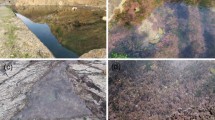Abstract
A significant proportion of the total primary production in the Celtic Sea (50°30′N; 07°00′W) has been found to be due to picoplankton and small nanoplankton. In July, August and October, 1982, 20 to 25% of the 14C fixed in primary production was in organisms >5 μm, 35 to 40% was in organisms <5–1 μm and 20 to 30% was in organisms<1 μm. Bacterial production was estimated by the incorporation of 3H and would account for less than 10% of the production in the <1–>0.2 μm fraction; therefore, production in the <1–>0.2 μm fraction was the result of photosynthesis per se by picoplankton and could not have been due to heterotrophic bacteria utilizing exudates from larger phytoplankton. Time-course experiments demonstrated some transfer of label from the <1–>0.2μm fraction to the >5 μm fraction, presumably by grazing, but again most of the production in this fraction was the result of photosynthesis by organisms larger than 5 μm and was not due to grazing by heterotrophic microflagellates on smaller phytoplankton.
Similar content being viewed by others
Literature cited
Aiken, J.: The undulating oceanographic recorder, Mark 2. J. Plankton Res. 3, 551–560 (1981a)
Aiken, J.: A chlorophyll sensor for automatic remote operation in the marine environment. Mar. Ecol. Prog. Ser. 4, 235–239 (1981b)
Boyd, C. M.: Selection of particle sizes by filter-feeding copepods: a plea for reason. Limnol. Oceanogr.. 21, 175–180 (1976)
Brewer, P. G. and J. P. Riley: The automatic determination of nitrate in seawater. Deep-Sea Res. 12, 765–772 (1965)
Chan, K. M. and J. P. Riley: The automatic determination of phosphate in seawater. Deep-Sea Res. 13, 467–471 (1966)
Fenchel, T.: Ecology of heterotrophic microflagellates. I. Some important forms and their functional morphology. Mar. Ecol. Prog. Ser. 8, 211–223 (1982a)
Fenchel, T.: Ecology of heterotrophic microflagellates. II. Bioenergetics and growth. Mar. Ecol. Prog. Ser. 8, 225–231 (1982b)
Fuhrman, J. A., J. W. Ammerman and F. Azam: Bacterioplankton in the coastal euphotic zone: distribution, activity and possible relationships with phytoplankton. Mar. Biol 60, 201–207 (1980)
Fuhrman, J. A. and F. Azam: Thymidine incorporation as a measure of heterotrophic bacterioplankton production in marine surface waters: evaluation and field results. Mar. Biol. 66, 109–120 (1982)
Gieskes, W. W. C., G. W. Kraay and M. A. Baars: Current 14C methods for measuring primary production: gross under-estimates in oceanic waters. Neth. J. Sea Res. 13, 58–78 (1979)
Herman, A. W., D. D. Sameoto and A. R. Longhurst: Vertical and horizontal distribution patterns of copepods near the shelf break of Nova Scotia. Can. J. Fish. aquat. Sciences 38, 1065–1076 (1981)
Hobbie, J. E., R. Daley and S. Jasper: Use of Nuclepore filters for counting bacteria by fluorescence microscopy. Appl. envirl Microbiol. 33, 1225–1228 (1977)
Johnson, P. W. and J. McN. Sieburth: Chroococcoid cyanobacteria in the sea: a ubiquitous and diverse phototrophic biomass. Limnol. Oceanogr. 24, 928–935 (1979)
Johnson, P. W. and J. McN. Sieburth: In-situ morphology and occurrence of eucaryotic phototrophs of bacterial size in the picoplankton of estuarine and oceanic waters. J. Phycol. 18, 318–327 (1982)
Joint, I. R. and A. J. Pomroy: Primary production in a turbid estuary. Estuar. cstl Shelf Sci. 13, 303–316 (1981)
Larsson, U. and Å. Hagström: Fractionated phytoplankton primary production, exudate release and bacterial production in a Baltic eutrophication gradient. Mar. Biol. 67, 57–70 (1982)
Le Corre, P. et P. Tréguer: Dosage de l'ammonium dans l'eau de mer: comparaison ente deux methodes d'analyse automatique. J. Cons. int. Explor. Mer 38, 147–153 (1978)
Li, W. K. W., D. V. Subba Rao, R. G. Harrison, J. C. Smith, J. J. Cullen, B. Irwin and T. Platt: Autotrophic picoplankton in the tropical ocean. Science, N. Y. 219, 292–295 (1983)
Marshall, S. M.: Respiration and feeding in copepods. Adv. mar. Biol. 11, 57–120 (1973)
Moriarty, D. J. W. and P. C. Pollard: DNA synthesis as a measure of bacterial productivity in seagrass sediments. Mar. Ecol. Prog. Ser. 5, 151–156 (1981)
Pingree, R. D., P. M. Holligan and G. T. Mardell: The effects of vertical stability on phytoplankton distributions in the summer on the northwest European Shelf. Deep-Sea Res. 25, 1011–1028 (1978)
Platt, T., D. V. Subba Rao and B. Irwin: Photosynthesis of picoplankton in the oligotrophic ocean. Nature, Lond. 301, 702–704 (1983)
Porter, K. G. and Y. S. Feig: The use of DAPI for identifying and counting aquatic microflora. Limnol. Oceanogr. 25, 943–948 (1980)
Sheldon, R. W.: Size separation of marine seston by membrane and glass-fiber filters. Limnol. Oceanogr. 17, 494–498 (1972)
Sieburth, J. McN., V. Smetacek and J. Lenz: Pelagic ecosystem structure: heterotrophic compartments of the plankton and their relationship to plankton size. Limnol. Oceanogr. 23, 1256–1263 (1978)
Steele, J. H.: The structure of marine ecosystems, 128 pp. Oxford: Blackwell 1974
Strickland, J. D. H. and T. R. Parsons. A practical handbook of seawater analysis. Bull. Fish Res. Bd Can. 167, 1–311 (1968)
Waterbury, J. B., S. W. Watson, R. R. L. Guillard and L. E. Brand: Widespread occurrence of a unicellular, marine planktonic cyanobacterium. Nature, Lond. 277 293–294 (1979)
Wiebe, W. J. and D. F. Smith: 14C labelling of the compounds excreted by phytoplanktion for employment as a realistic tracer in secondary productivity measurements. Microb. Ecol. 4, 1–8 (1977)
Williams, P. J. Le B.: Incorporation of microheterotrophic processes into the classical paradigm of the planktonic food web. Kieler Meeresforsch. 5, 1–28 (1981)
Williams, P. J. Le B.: Bacterial production in the marine food chain: the Emperor's new suit of clothes? In: Flows of energy and materials in marine ecosystems: theory and practice, Ed. by M. J. R. Fasham London Plenum Press (in press) 1983
Author information
Authors and Affiliations
Additional information
Communicated by J. Mauchline, Oban
Rights and permissions
About this article
Cite this article
Joint, I.R., Pomroy, A.J. Production of picoplankton and small nanoplankton in the Celtic Sea. Mar. Biol. 77, 19–27 (1983). https://doi.org/10.1007/BF00393206
Accepted:
Issue Date:
DOI: https://doi.org/10.1007/BF00393206




